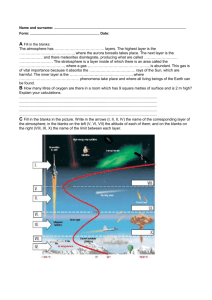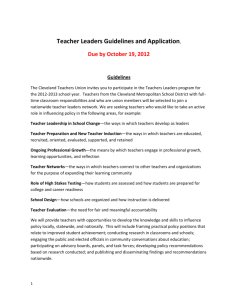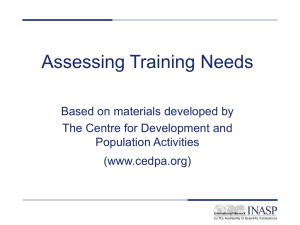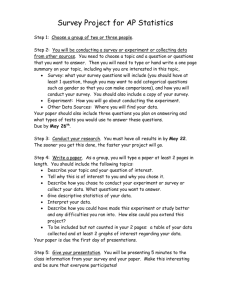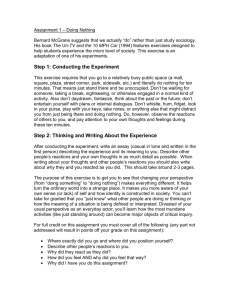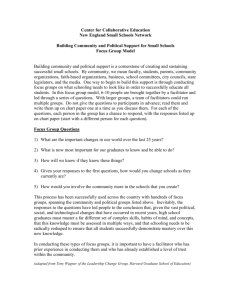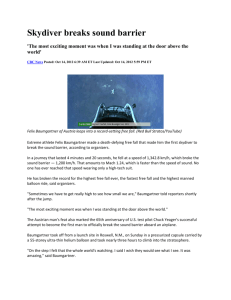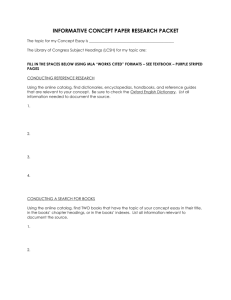Chapter 16
advertisement
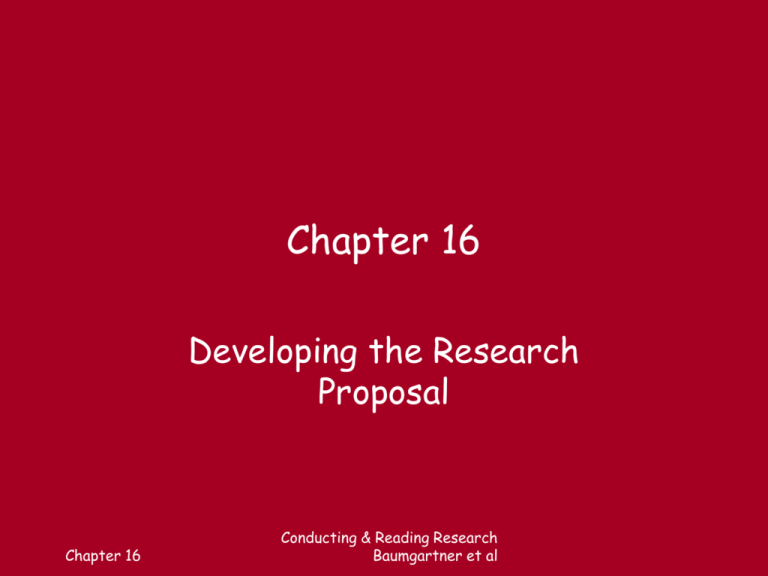
Chapter 16 Developing the Research Proposal Chapter 16 Conducting & Reading Research Baumgartner et al Steps in the Research Process Narrow to specific problem Develop approach Identify question State hypotheses Identify sample Design data collection plan Select collection procedures Choose analysis Chapter 16 Implement plan Prepare report Conducting & Reading Research Baumgartner et al Review literature Selecting the Problem - Tips 1. While reading, attending lectures, write down ideas immediately. 2. Research a subject for a paper. 3. What questions seem unresolved? 4. Challenge commonly accepted beliefs. 5. Look at master’s & doctoral studies. 6. Discuss ideas, topics with professors or other researchers. Chapter 16 Conducting & Reading Research Baumgartner et al Defining the Problem • Literature search – conceptual literature – related research • Consider your interest in the problem • Consider the “importance” of the problem • Consider whether researching the problem is a feasible task Chapter 16 Conducting & Reading Research Baumgartner et al Developing the Research Proposal • • • • Title Chapter 1: Introduction Chapter 2: Literature Review Chapter 3: Procedures Chapter 16 Conducting & Reading Research Baumgartner et al Chapter 1: Introduction • • • • • • • Statement of problem Significance of study Delimitations Limitations Assumptions Hypotheses Definition of Terms Chapter 16 Conducting & Reading Research Baumgartner et al Statement of problem • problem statement: declarative statement indicting question addressed in research project • Example: The focus of the study was to determine whether particular variations within the CHRNA4 gene are associated with smoking behaviors. Chapter 16 Conducting & Reading Research Baumgartner et al Purpose of the study • purpose statement: indicates why the study was done • Example: The purpose of the study was to facilitate identification of individuals at risk for becoming addicted to nicotine. Chapter 16 Conducting & Reading Research Baumgartner et al Significance of the study • Possible reasons: 1. Gaps exist between theoretical and practical aspects of the problem. 2. More & better knowledge is needed. 3. Current knowledge needs to be validated. 4. Current practices need to be clarified/improved. 5. There is no known solution to the problem. Chapter 16 Conducting & Reading Research Baumgartner et al Example • Identifying a gene that is associated with smoking may help: – Target prevention programs toward atrisk adolescents – Assist in understanding the biological basis of addiction to nicotine – Lead to the development of pharmaceutical treatments for smokers who wish to quit Chapter 16 Conducting & Reading Research Baumgartner et al Delimitations – scope of study • Description of subjects • Description of variables • Description of tests, instruments, procedures • Description of special equipment • Type of training • Time and duration of study • Analytical procedures Chapter 16 Conducting & Reading Research Baumgartner et al Limitations (weaknesses) • • • • • • • • Approach, design, method, techniques Sampling problems Uncontrolled variables Errors in test administration or data handling Generalizability of data Representativeness of subjects Compromises to internal and external validity Reliability and validity of research instruments Chapter 16 Conducting & Reading Research Baumgartner et al Assumptions • Usually drawn from literature or previous experiments • Example: We assume the same genes are important in different populations for mediating smoking behavior. We assume the genes contribute enough of an effect to the behavior to be able to be observed. Chapter 16 Conducting & Reading Research Baumgartner et al Hypotheses • Statement of what you predict the results of the study will reveal. • Example: There is an association between a variant in the CHRNA4 gene and the number of cigarettes smoked each day. Chapter 16 Conducting & Reading Research Baumgartner et al Definition of terms • Important for terms that may have multiple meanings • Example tobacco use: ever tried, tried at least 5 times, used on a daily basis, used only in bars, used five years ago… Chapter 16 Conducting & Reading Research Baumgartner et al Working bibliography • Listing of all sources pertinent to the problem • notecards, notepads, computerized reference databases • Include author, title, year, journal or book, volume, issue, publisher, page numbers, etc. Chapter 16 Conducting & Reading Research Baumgartner et al Chapter 2: Literature Review • Needs to present broad background of the research related to the problem • Not a simple listing of other works • Should bring together results from multiple studies to draw conclusions, relationships • Should facilitate identification of problems, gaps that need to be addressed Chapter 16 Conducting & Reading Research Baumgartner et al Chapter 3: Procedures • Aka Methodology, Experimental Procedures, Survey Procedures • Data collection plan • Step-by-step instructions • Extremely detailed, so someone else could replicate the study Chapter 16 Conducting & Reading Research Baumgartner et al Procedures: General Guidelines • • • • Restatement of problem Overview of organization of chapter Description of subjects, sampling methods Description of tests, instruments, measures • Description of study design • Description of administrative procedures • Description of analysis of data Chapter 16 Conducting & Reading Research Baumgartner et al Steps in the Research Process Narrow to specific problem Develop approach Identify question State hypotheses Identify sample Design data collection plan Select collection procedures Choose analysis Chapter 16 Implement plan Prepare report Conducting & Reading Research Baumgartner et al Review literature

